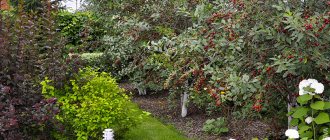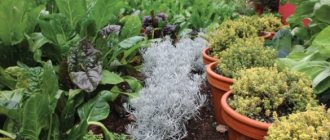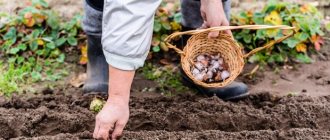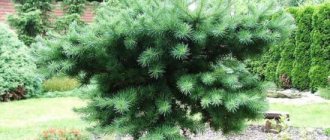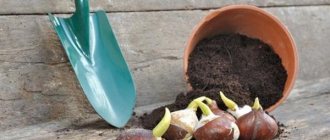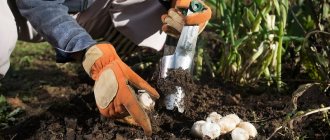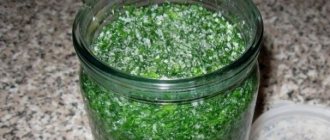Introduction
The quality of the material is of great importance
When you start planting vegetable crops in winter for the first time, you need to very carefully select the crops and their varieties suitable for this. They must have good resistance to autumn cold and winter frost.
Otherwise, unsuccessful landings cannot be avoided. Early varieties are more resistant to low temperatures.
When buying seeds, saving is not appropriate. According to the experience of summer residents, it is better to leave the choice to granules. The seed is protected in them, which reduces the risk of death.
Below is a table with all the main plants and their varieties, corresponding to their characteristics for sowing for the winter season.
Suitable crops and their groups
| Vegetable name | Recommended species for autumn sowing |
| CABBAGE | |
| Broccoli | • Gnome • Monterey • Calabrese • Lucky • Caesar • Laser |
White cabbage | • Nadezhda • Polar K-206 • Vyuga • Sibiryachka • Zarya • Dumas • Gribovsky |
Red cabbage | • Gako 741 • Stone head 447 • Early red • Early hard stone |
Beijing | • Khivinskaya 5 |
Colored | • Movir 74 • Domestic • Warranty |
POTATO | • Volzhanin • Vorotynsky early • Volzhsky |
| ONION | |
| Batun | • Saladny 35 • Maysky • Gribovsky 21 • April 12 |
Multi-tiered | • Likova • Odessa winter 12 |
Bulb | • Ellan • Strigunovsky local • Bessonovsky local • Stuttgarten Risen • Myachkovsky 300 • Odintsovets • Timiryazevsky • Carmen |
SWEDE | • Krasnoselskaya • Swedish • Green-headed yellow |
CARROT | • Nantes 4 • Karotel • Incomparable • Moscow Winter A 515 • Vitamin 6 • Shantane 2461 • Shantane 14 • Losinoostrovskaya 13 • Artek • Early TSHA • Supernant • NIIOH 336 • Perfection (Perfecten) • Fun • Canning |
RADISH | • Zarya • Dungan 12/8 • Heat • Long-lasting • Rose-red with white tip • Greenhouse |
RADISH | • Grayvoronskaya • Sudarushka • Viela • Delicacy • Winter round black • Winter round white • Chernavka |
TURNIP | • White Night • Geisha • Petrovskaya 1 |
BEET | • Podzimnyaya A-474 • Cold-resistant 19 • Podzimnyaya incomparable • Gribovskaya flat A-473 • Northern ball • Egyptian flat • Polar flat K-249 • Detroit • Red ball |
pros
Strong seeds will germinate over the winter
Planting before frost has its positive sides:
- Germination of sprouts occurs in 14-20 days. earlier, compared to seedlings planted in the spring season. This will allow you to collect early root crops, and the areas that are vacated in the summer can be planted again
- Over the winter, strong seeds will germinate, while weakened and unhealthy seeds will die. This will make the plants more resilient to sudden frosts and possible diseases and increase their fertility
- Thanks to melt water in the spring, the seeds will swell faster, receiving sufficient moisture. While spring plantings often lack water, especially during warm and dry seasons
- The plant, planted before the winter season, requires minimal care. It must be planted, watered, fertilized, mulched or covered with a special coating.
- If the purchased seeds turned out to be of poor quality and did not germinate after winter, you can always re-sow the bed
Minuses
Care is required in selecting varieties
Despite all the advantages, planting in the fall is a risk:
- If you plant vegetables without taking into account the climatic and weather conditions of the area, you can harm them without the possibility of recovery
- In autumn, rodents are most active and can ruin all the work
- The tendency of some crops to go into decline in early spring, so you need to be more careful when choosing varieties
It is not possible to say definitely when exactly it can be planted in the fall. Everything depends on weather conditions. The most suitable period is the time that comes after all the foliage has fallen and before the onset of the first frost.
Preparing the beds
Installing boards around the perimeter of the bed
For pre-winter sowing, it plays a big role how well the sown areas were prepared. They must be reliably protected and well fertilized so that the seeds can survive the winter in an open space.
The size of the bed does not need to be large. A total area of 5-6 m2 can provide a family of up to 5 people with early vegetables.
It is best to arrange high beds or install boards, slate, polycarbonate or other material around the perimeter of the sown area. This will protect the sown seeds from melt water and will be able to retain the snow cover on the ridge.
The location is chosen, illuminated and elevated, where with the onset of warmth the snow will melt earlier. It should also be protected from the wind. Additionally, you can install a fence on the side where the wind blows. With small amounts of precipitation during the winter period, the layer of snow on the bed is replaced by a mulch layer.
Areas for sowing are prepared in advance. The soil must be weeded and fertilized (the nitrogen content should be low). Seed grooves are prepared to a depth of 3-5 cm. The finished area must be covered to prevent excessive moisture.
A mulching substrate is prepared separately (soil from the garden, to which peat and sand are added in a ratio of 1:2:1). We just have to wait for the first cold snap.
Sowing before the onset of frost is fraught with early germination of seeds at above-zero temperatures and their death with the first frost.
Greens that can be planted before winter
To obtain aromatic and healthy vitamin products, greens are also planted in the fall. Cold-resistant crops are mainly suitable for this.
Onion sets - planting in winter
The main advantages of sowing greens before winter:
- plants undergo stratification (hardening);
- resistance to diseases and pest damage;
- reduction of germination time.
Depending on regional climatic characteristics, early products are obtained by sowing:
- cilantro;
- salads;
- wild garlic;
- celery;
- dill;
- caraway;
- leaf parsley;
- leeks;
- fennel;
- spinach;
- sage;
- mustard;
- arugula.
Sorrel can be used at the end of spring. By following agrotechnical rules, you can get a full harvest of greenery without loss or damage. The germination rate of such plantings is usually much higher and more intense.
You should choose beds in those parts of the garden where the soil warms up the most. It’s good if it falls on the sunny side, protected from drafts. This way the plants will grow faster and will be less susceptible to damage from precipitation. The most suitable are hillocks and southern slopes of a personal plot.
Advice! The beds should be prepared in advance, 10-12 days before the planned work, so that the earth settles.
Onion sets also grow well after planting before winter. The bulbs are larger than those planted in the spring. And green feather leaves can be used in the diet before the beginning of summer.
Planting rules
Seeds must be dry
When a stable subzero temperature is established, sowing begins. Although some summer residents practice winter sowing (January, February). This is possible in areas where instability of autumn weather can cause early seed germination. But you will need to stock up on soil to cover the frozen holes.
In the south, this method is used for planting in the winter months (January or February), when the ground begins to thaw, but is not yet warm enough for the seeds to begin to grow.
The number of seeds is taken twice as much. They must be dry. Above the holes, the earth becomes slightly compacted. This will improve the tenacity of the seeds to the soil. Next, everything is covered with mulch to insulate the sown material. The coating layer must be at least 15 cm.
If foliage is used as a covering material, it must be secured so that it does not blow across the area by the wind. If little snow falls during the winter, you will need to add more snow to the ridge yourself.
Beds under agrofibre
Watering for autumn planting is not required, because... There will be excess moisture from melt water for seeds.
In early spring, the ridges are covered with polyethylene, which is stretched over prepared wire arches. This will allow the soil to warm up, which will accelerate the germination and development of the sown material, and will also provide protection if frost returns.
Let us consider in more detail the necessary conditions for planting using the example of each individual crop.
Cabbage
Cabbage
Cabbage In practice, the crop is rarely planted before winter, because it needs a warm climate. Although for the southern regions this is also risky. Shoots appear quite quickly and, if the weather in spring is unstable, there is a high probability that they may freeze.
When deciding to plant cabbage before winter, you need to choose only the recommended varieties.
Recommended seed depth is from 1.5 cm to 3 cm.
Sowing volume – up to 0.2 g/m2.
Potato
Potato
Potatoes Potatoes are usually not planted in winter. But when the tubers are buried 10-15 cm, they are able to perfectly tolerate low temperatures down to -100C. The weight of the potato should be about 100-150 g.
Planting occurs without vernalization during a period when frosts begin at night and the temperature rises during the day. The soil has the ability to thaw.
Double beds are used for planting crops. This allows you to place wire arches over the rows in the spring season. Planted in a checkerboard pattern.
Recommended fruit depth is 15-20 cm.
Recommended settings:
| Bed width, cm | Gap between ridges, cm | Spacing between rows, cm | Gap between fruits, cm |
| 70 | 80 | 45 | 25-30 |
Onion
Onion
1 Batun can be planted three times per period. Winter sowing is considered the simplest.
The recommended depth of material is from 2 cm to 2.5 cm.
Sowing rate – 6-8 g/m2.
Recommended settings:
| Interval between crops, cm | Spacing between rows, cm |
| 20-25 | 40-50 |
Multi-tiered bow
2 Multi-tiered onions are not afraid of low temperatures down to -400C. But there is one caveat - by the winter, the crop should have formed good roots. Bulbs are planted 14 days in advance. before the onset of frost in 2-3 lines.
The recommended depth of the bulb is 3-4 cm.
The thickness of the material is about 2 cm.
Sowing rate – up to 0.5 g/sq.m. m.
Recommended settings:
| Gap in line, cm | Spacing between rows, cm |
| 15-20 | 30 |
Onion
3 Onions are planted 1 month before the first frost. During this time it should take root well. As the temperature drops to -50C, the planted material is covered with a layer of mulch of at least 15 cm. This will prevent the bulbs from freezing.
Also, the mulch layer will prevent the ground from thawing during late autumn above-zero temperatures.
The thickness of the material is about 1 cm.
Recommended settings:
| Gap between bulbs, cm | Spacing between rows, cm |
| 5-6 | 15-20 |
Those who love green onions should plant the material more densely (with a gap of 2-3 cm).
Swede
Swede
Rutabaga is a cold-resistant crop and winter sowing is possible even after the onset of stable sub-zero temperatures. Sprouted shoots can withstand frosts down to -2...-30C, large plants - up to -3...-50C.
For full development and formation of tubers, a temperature of 15-180C is required.
Usually in the fall, rutabaga is sown at the end of October - early November.
Carrot
Carrot
Carrots are sown at a temperature of +2…+40C. The ridge is prepared in advance so that the soil can settle before sowing.
The recommended depth of material for sowing is 3-4 cm.
The width between the ranks is 15-20 cm.
Sowing rate – 1 g/m2.
Carrots have been harvested selectively since the beginning of June. Fruits sown in autumn, compared to those planted in spring, are worse in storage. Therefore, you need to think about what specific volume will be needed.
Radish
Radish
Radishes are distinguished by good seed germination even at low temperatures. Therefore, there is no need to rush into sowing. The optimal period is the end of November.
The recommended depth of the seeded material is about 3 cm.
Sowing volume – 5-10 g/m2.
Recommended settings:
| Gap between plantings, cm | Width between rows, cm |
| 4-6 | 10-15 |
Turnip
Turnip
Turnips are sown 14 days before the onset of established frosts. This method allows the crop to form early, which saves the crop from attack by the cruciferous flea beetle.
The recommended depth of the seeded material is 3 cm.
Sowing volume – 2 g/m2.
Turnips are planted with 3 seeds in each hole. The fruits sown before the cold weather can be harvested as early as the end of May.
Recommended settings:
| Gap between plantings, cm | Spacing between rows, cm |
| 15 | 25-30 |
Beet
Beet
Beets begin to hatch at a temperature of +50C. Therefore, winter planting should be done during an already established cold snap (-2...-40C).
The recommended depth of seed is 3-4 cm.
Sowing rate – 4 g/m2.
The first winter-sown crop is ready for harvest in early June. Root crops sown in autumn are poorly stored.
Recommended settings:
| Gap between plantings, cm | Distance between shegengs, cm |
| 5-10 | 20-30 |
Work in the garden before winter
In the garden, autumn work is carried out even after frost, in areas prepared in advance for planting. To do this, the beds are pre-prepared: weeds are removed and dug up, grooves are cut or holes are dug. Even in cases when the first snow falls, agricultural work can be carried out. It is raked, seeds are sown directly on the surface of the soil and sprinkled with peat or humus on top.
It is preferable to sow all cold-resistant crops in loose soil. To do this, when preparing the beds, sand and sawdust are added to the soil, and then dug up. Add humus or compost. If necessary, phosphorus fertilizers are applied to depleted soils, but preference should be given to organic matter.
In northern regions with cold climates, “warm” beds are practiced. To do this, the soil is selected to a depth of 50 cm and horse or sheep manure is laid at the bottom of the trench. Sprinkle a layer of fertile soil on top and compact it. Such plantings are most resistant to frost due to the methane produced during the decomposition process.
In early spring, to protect the seedlings, they are covered with film or agrofibre. After the onset of warmth, in early spring, the shelters are removed and the ground is loosened. Thinning is required. Only the strongest shoots are left. If desired, the remaining seedlings are planted in boxes and pots for further planting in open ground.
Care rules for the spring season
In early spring, everything is covered with film for insulation.
Vegetables planted before the cold weather germinate very early in the spring. At this time, no one thinks about planting. The weather is still too cold and the small sprouts need extra care.
If pre-winter sowing was carried out in a greenhouse complex, the first young plants will sprout very early, when frosts still linger at night, and the sun’s rays are deceptive during the day.
For this reason, the seedlings need to be covered from above or worry about additional devices to heat the room.
When planting in an open space before winter, with the first melting of snow, wire arches are installed on the ridge. The film is stretched over them. This will speed up the ripening of the fruit by another 1-2 weeks.
During the winter period, the soil cakes and a compacted crust forms on top. It makes it very difficult for small sprouts to get to the top. To help them, as soon as the snow melts, it is necessary to carefully loosen the soil on the ridge and break the resulting crust.
In the future, caring for the plants will come down to weeding, watering and processing them in a timely manner.
Planting before cold weather will not free you from planting in the spring season, because not all crops can overwinter in open space. But harvested fruits in early spring can save quite a lot of time and money, because you won’t need to purchase many crops at the store. Ready-made vitamins will be available fresh in your garden.
Pre-winter planting of flowers
Among flower crops there are many species that require stratification for more friendly shoots. Most often, cold-resistant annuals are sown in winter: asters, calendula, godetia, gypsophila, matthiola, snapdragon, cosmos, eschscholzia.
Among the perennials in the fall, you can sow garden chamomile, gaillardia, lavatera, carnation, bellflower, aquilegia, yarrow, and doronicum. In the future, these plants reproduce well by self-sowing. As a result, flower growers make it easier for gardeners to decorate their spring gardens and get earlier and longer flowering.
In winter, some bulbous and rhizomatous plants are planted or transplanted. First of all, tulips, irises, daylilies, lilies, daffodils, crocuses, hyacinths, muscari, peonies, primrose, phlox.
Here, planting dates begin at the beginning of September, since the plants early go into a state of rest and adapt to the accumulation of nutrients in the bulbs and rhizomes. In autumn, the plants will take root and will delight you with flowering in the new season.

